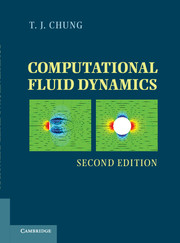Book contents
- Frontmatter
- Contents
- Preface to the First Edition
- Preface to the Revised Second Edition
- Part One Preliminaries
- Part Two Finite Difference Methods
- Part Three Finite Element Methods
- Part Four Automatic Grid Generation, Adaptive Methods, and Computing Techniques
- Part Five Applications
- Chapter Twenty-One Applications to Turbulence
- Chapter Twenty-Two Applications to Chemically Reactive Flows and Combustion
- Chapter Twenty-Three Applications to Acoustics
- Chapter Twenty-Four Applications to Combined Mode Radiative Heat Transfer
- Chapter Twenty-Five Applications to Multiphase Flows
- Chapter Twenty-Six Applications to Electromagnetic Flows
- Chapter Twenty-Seven Applications to Relativistic Astrophysical Flows
- Appendixes
- Index
- References
Chapter Twenty-Three - Applications to Acoustics
from Part Five - Applications
Published online by Cambridge University Press: 05 June 2012
- Frontmatter
- Contents
- Preface to the First Edition
- Preface to the Revised Second Edition
- Part One Preliminaries
- Part Two Finite Difference Methods
- Part Three Finite Element Methods
- Part Four Automatic Grid Generation, Adaptive Methods, and Computing Techniques
- Part Five Applications
- Chapter Twenty-One Applications to Turbulence
- Chapter Twenty-Two Applications to Chemically Reactive Flows and Combustion
- Chapter Twenty-Three Applications to Acoustics
- Chapter Twenty-Four Applications to Combined Mode Radiative Heat Transfer
- Chapter Twenty-Five Applications to Multiphase Flows
- Chapter Twenty-Six Applications to Electromagnetic Flows
- Chapter Twenty-Seven Applications to Relativistic Astrophysical Flows
- Appendixes
- Index
- References
Summary
Introduction
Acoustics is the science that deals with sound waves such as in a combustion chamber, jet noise, oceanography, meteorology, architectural acoustics, and environmental acoustics. Sound waves may occur in the quiescent air even with extremely small pressure disturbances. This could lead to a noise audible to the human ear. In this case, changes in all flow variables other than the pressure remain constant. On the other hand, the noise level can be extremely high (thunder or explosion), but still with fluctuations of all variables other than the pressure remaining more or less constant. This phenomenon may be referred to as the pressure mode acoustics. When fluids undergo circulations causing significant velocity gradients, vortical waves are generated, which then produce pressure disturbances. The noise coming from this action (vorticity) may be categorized as the vorticity mode acoustics. In many instances in nature or in engineering, we encounter rapid changes in temperature such as in hypersonic flows over a spacecraft creating an entropy boundary layer between the shock layer and velocity boundary layer, subsequently leading to pressure fluctuations. Entropy waves are predominant in this case. We may identify the noise generated by entropy waves as the entropy mode acoustics.
The categorization suggested above was actually originated by Kovasznay [1953]. It is our intention to follow his suggestion in this chapter. However, it appears that the research in the acoustics community in general has been centered around acoustic waveforms (linear and nonlinear–N-waves), sound emission (radiation), and sound absorption (viscous dissipation), under which a large number of subdivided disciplines can be identified. Selection of example problems under such vast subject areas is difficult for the purpose of this chapter, which is concerned only with an introduction of computational acoustics. Thus, instead, in adopting the suggested categorization by pressure mode acoustics, vorticity mode acoustics, and entropy mode acoustics, it is necessary that appropriate governing equations be identified. For example, we may select suitable topics for the pressure mode acoustics in which the Helmholtz equation or its variant such as the Kirchhoff’s formula is used. For the vorticity mode acoustics, standard vorticity transport equation(s), Lighthill’s acoustic analogy, or Ffowcs Williams-Hawkings equation may be invoked. Pressure disturbances arising from the solution of these equations will contribute to the vorticity mode acoustics. Using the first and second laws of thermodynamics, the energy equation can be derived in terms of entropy in a variety of forms. In this process, the pressure disturbances and the entropy noise from this calculation is identified as the entropy mode acoustics. In all cases, it is useful to obtain analytical expressions for the pressure fluctuations from the governing equations used for each of the modes. Here, the concept of Green’s function will play a major role. In general, however, solutions of the Navier-Stokes system of equations can provide the most useful information. With proper filtering process (or time averages), the fluctuation components of all variables including the pressure fluctuations and the root mean squared pressure (prms) are calculated to determine the noise level.
Information
- Type
- Chapter
- Information
- Computational Fluid Dynamics , pp. 806 - 850Publisher: Cambridge University PressPrint publication year: 2010
